Why Going It Alone Feels Safer
You’ve always been the one people can count on.
Competent. Reliable. Independent.
For many high-achievers, this independence is tied to the fear of asking for help in imposter syndrome, a mix that fuels the Soloist Pattern.
On the outside, it looks like you’re thriving. Inside, though, you may feel the weight of having to do everything yourself. The idea of asking for help sparks anxiety: What if they realize I don’t really know what I’m doing?
This is the Soloist Pattern, one of the most common faces of imposter syndrome. It shows up in high-achievers who pride themselves on independence, but secretly fear that collaboration will expose them as a fraud.
This post is Part 3 of my Imposter Syndrome Series. If you missed the first two, you can catch up here:
What Is the Soloist Pattern?
The Soloist is a survival strategy: If I do it all myself, no one can criticize me, and no one will find out I don’t belong.
This pattern often starts early. For some, self-sufficiency was praised while vulnerability was dismissed. Others learned that depending on people led to disappointment, rejection, or even danger. Over time, independence became equated with safety.
How the Soloist Pattern Shows Up in the Fear of Asking for Help
The Soloist Pattern often looks like strength on the outside but carries hidden emotional and physical costs. High-achievers may:
-
Overpreparing instead of asking for help – Spending hours polishing work instead of sharing drafts early.
-
Avoiding mentorship – Turning down guidance for fear of being “found out.”
-
Keeping struggles invisible – Shouldering challenges without letting others know how hard it feels.
-
Difficulty delegating – Believing no one else can meet their standards.
-
Equating help with weakness – Viewing collaboration as failure instead of wisdom.
These behaviors create a cycle of independence → overwork → exhaustion → isolation → self-doubt, which keeps the Soloist Pattern going.
Recognizing these patterns is the first step toward shifting them.
The Superwoman Pattern reinforces this, making rest feel like weakness and asking for help feel like failure. While the Soloist fears exposure through collaboration, the Superwoman feels she must carry everything flawlessly while keeping everyone else steady.
Why the Fear of Asking for Help Fuels Imposter Syndrome
For high-achievers, especially women in competitive fields like tech, finance, and healthcare, asking for help can feel risky. The fear isn’t just about the task itself. It’s about identity. To understand where this fear comes from, let’s look at what shapes it.
Fear of Exposure: If you ask for help, there is the fear that doing so will confirm that you don’t really belong. This echoes the heart of imposter syndrome (Clance & Imes, 1978).
The Childhood Roots of the Soloist Pattern
Early Conditioning: Many Soloists were rewarded as children for being “the responsible one” or the helper, not the one needing help. Research on parentification shows that some also experienced having to care for siblings or emotionally support adults, learning early that their role was to give, not receive, support (Hooper et al., 2008). Vulnerability may have felt unsafe or even punished.
I understand this pattern both personally and professionally. Growing up, I was often praised for being “the responsible one” and felt a deep sense of duty to care for my younger brother. That early conditioning shaped how I equated independence with safety for years, until I learned that true strength comes from being able to rely on others, too.
What begins as a personal coping mechanism often becomes reinforced by surrounding systems, especially in workplaces that reward individual achievement over collaborative efforts.
External Factors That Reinforce the Soloist Pattern
Workplace Culture: In male-dominated or high-stakes industries, the fear of asking for help in imposter syndrome can be misread as weakness. Independence is often glorified, though research suggests many organizations are beginning to value collaboration more highly (Grant, 2013). Still, studies show that needing help can be misread as weakness, especially for women navigating environments where they’re already proving their competence (Rudman & Glick, 2001). Beyond the workplace, culture also plays a powerful role in shaping how we relate to independence and support.
Cultural and Individual Differences: One’s cultural background can also influence the Soloist Pattern. Cross-cultural research reveals that those from individualistic cultures (common in the U.S. and Western Europe) may face additional pressure to “go it alone,” while those from collectivistic backgrounds might struggle with different expectations around group harmony versus personal needs (Hofstede, 2001; Markus & Kitayama, 1991).
In addition, some people naturally lean toward independence, which can be a strength. The key is recognizing when this healthy trait becomes a rigid, fear-based pattern that fuels imposter syndrome.
One Example: Maya’s Story
Maya (a composite of several clients) was a mid-level manager in a fast-paced tech company. She was known for being dependable, the one who could handle anything thrown at her.
But behind the scenes, she worked late nights, often redoing tasks others had delegated to her.
When her director suggested she find a mentor, Maya brushed it off. If I can’t figure it out on my own, maybe I’m not leadership material, she thought.
Eventually, Maya burned out. In therapy, she began to unpack the Soloist Pattern: a childhood where she had to be “the capable one,” and a career culture that rewarded independence but punished vulnerability.
With practice, she started asking for small pieces of help, first from peers, then from mentors. Instead of being dismissed, she found her contributions were valued more.
Over time, Maya not only lightened her load but was promoted, precisely because she could lead collaboratively. Maya’s story shows how the fear of asking for help in imposter syndrome leads to overwork and exhaustion.
How Being the Soloist Keeps You Stuck
While independence is a strength, overdoing it can quietly sabotage success:
Exhaustion: Carrying everything alone eventually leads to burnout.
Missed Opportunities: Refusing mentorship or collaboration means you lose out on fresh ideas, networks, and growth.
Isolation: The Soloist can feel lonely. Without support, you shoulder stress in silence.
Reinforced Imposter Syndrome: By avoiding help, you never get reality checks that prove your competence. The cycle repeats: “If I need help, I must not belong.”
What starts as protection ends up fueling the very self-doubt you’re trying to escape.
How to Overcome the Fear of Asking for Help in Imposter Syndrome: 9 Practical Strategies
Breaking free doesn’t mean swinging to the opposite extreme and depending on everyone for everything. Healthy independence remains valuable. However, it’s the rigid, fear-driven version that limits us. The goal is learning to see help-seeking as a form of strength and strategic thinking, not weakness.
The below strategies are designed to help quiet achievers overcome the fear of asking for help in imposter syndrome while keeping healthy independence intact.
1. Name the Story
Catch yourself when the Soloist script plays: If I ask for help, I’ll look incompetent. Naming it helps you question it.
2. Reframe Help-Seeking as Leadership
Strong leaders don’t do everything alone. They know how to gather resources and build teams. Asking for help signals wisdom, not weakness.
3. Try Safe Experiments
Share a draft early with a trusted colleague. Notice that feedback is often supportive, not critical. Over time, this builds new evidence.
4. Ask Small, Safe Questions
Start with low-stakes requests: “Do you have a resource for this?” or “Could you look this over?” Build confidence gradually.
5. Celebrate Collaborative Wins
When teamwork improves outcomes, acknowledge it. Add it to your “done list.” This retrains your brain to value connection.
6. Practice Self-Compassion
When shame arises, pause and ask: Would I judge a friend for needing support? Likely not. Offer yourself that same grace (Neff, 2003).
7. Seek Mentorship as Mutual
Mentors often find meaning in guiding others. Asking isn’t just taking; it’s creating connection that benefits both sides.
8. Build Community
Join professional groups, therapy groups, or peer circles. Normalizing help-seeking makes it feel less risky.
9. Heal the Roots with Therapy & EMDR
For many Soloists, the fear of asking for help is tied to old experiences where vulnerability wasn’t safe. EMDR and trauma-informed therapy can reprocess those memories so your nervous system learns: It’s safe to lean on others now.
For clients who prefer a more focused, immersive approach, EMDR Therapy Intensives offer extended time to do this work in a contained, structured way – while still honoring your independence and need for control.
Why This Matters
Independence is valuable, but when it becomes a rigid rule, it limits both success and well-being.
High-achievers who learn to collaborate and seek support often discover:
Less burnout and more energy.
Greater visibility and leadership opportunities.
Stronger relationships and sense of belonging.
You don’t have to carry it all alone. In fact, your growth may depend on learning to share the load.
Frequently Asked Questions
Q: Why do successful women struggle to ask for help at work?
A: Many were conditioned early to equate independence with worth and safety. In professional settings, this becomes the Soloist Pattern, where asking for help feels like it will expose incompetence or weakness.
Q: How is the Soloist Pattern connected to imposter syndrome?
A: The Soloist Pattern reflects the fear of asking for help in imposter syndrome, where support feels like exposure instead of strength.
Q: Can therapy help someone overcome the fear of asking for help?
A: Yes. Therapy, particularly trauma-informed approaches and EMDR, can help reprocess early experiences where vulnerability felt unsafe and build new, healthier patterns of connection and collaboration.
Q: Is the Soloist Pattern more common in certain cultures or industries?
A: While it can appear anywhere, it’s often more pronounced in individualistic cultures and competitive industries like tech, finance, and healthcare, where independence is highly valued and collaboration may be less explicitly rewarded.
Closing Thoughts
The Soloist Pattern can make life feel lonely, exhausting, and filled with self-doubt. Yet once you begin to see help-seeking as wisdom, not weakness, you open the door to genuine growth, connection, and confidence.
This post is Part 3 of my Imposter Syndrome Series, exploring the hidden patterns that keep high-achievers doubting their worth, and how to shift them.
References
Byng-Hall, J. (2002). Relieving parentified children’s burdens in families with insecure attachment patterns. Family Process, 41(3), 375–388.
Clance, P. R., & Imes, S. A. (1978). The imposter phenomenon in high achieving women: Dynamics and therapeutic intervention. Psychotherapy: Theory, Research & Practice, 15(3), 241–247.
Grant, A. (2013). Give and take: Why helping others drives our success. Penguin Books.
Hofstede, G. (2001). Culture’s consequences: Comparing values, behaviors, institutions and organizations across nations(2nd ed.). Sage Publications.
Hooper, L. M., Marotta, S. A., & Lanthier, R. P. (2008). Predictors of growth and distress following childhood parentification: A retrospective exploratory study. Journal of Child and Family Studies, 17(5), 693–717.
Markus, H. R., & Kitayama, H. (1991). Culture and the self: Implications for cognition, emotion, and motivation. Psychological Review, 98(2), 224–253.
Neff, K. D. (2003). The development and validation of a scale to measure self-compassion. Self and Identity, 2(3), 223–250.
Rudman, L. A., & Glick, P. (2001). Prescriptive gender stereotypes and backlash toward agentic women. Journal of Social Issues, 57(4), 743–762.
Published: October 4, 2025

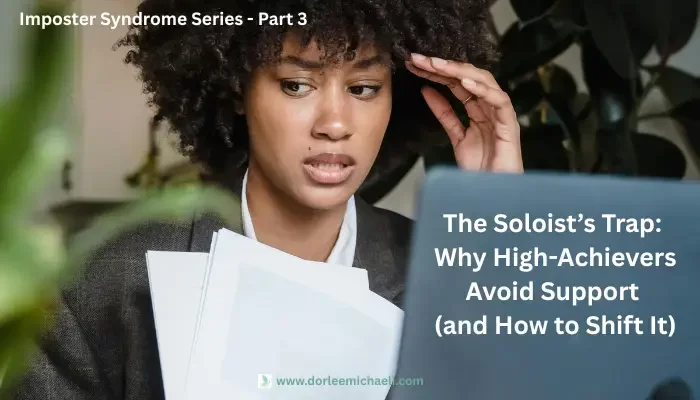
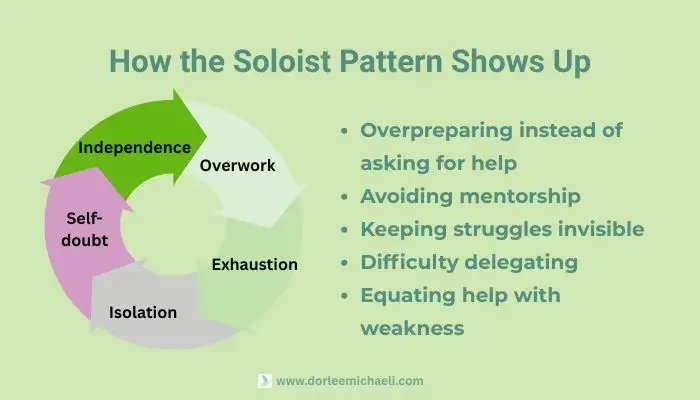
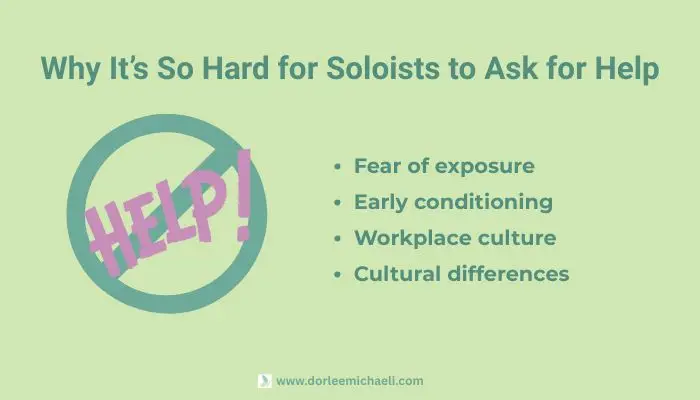
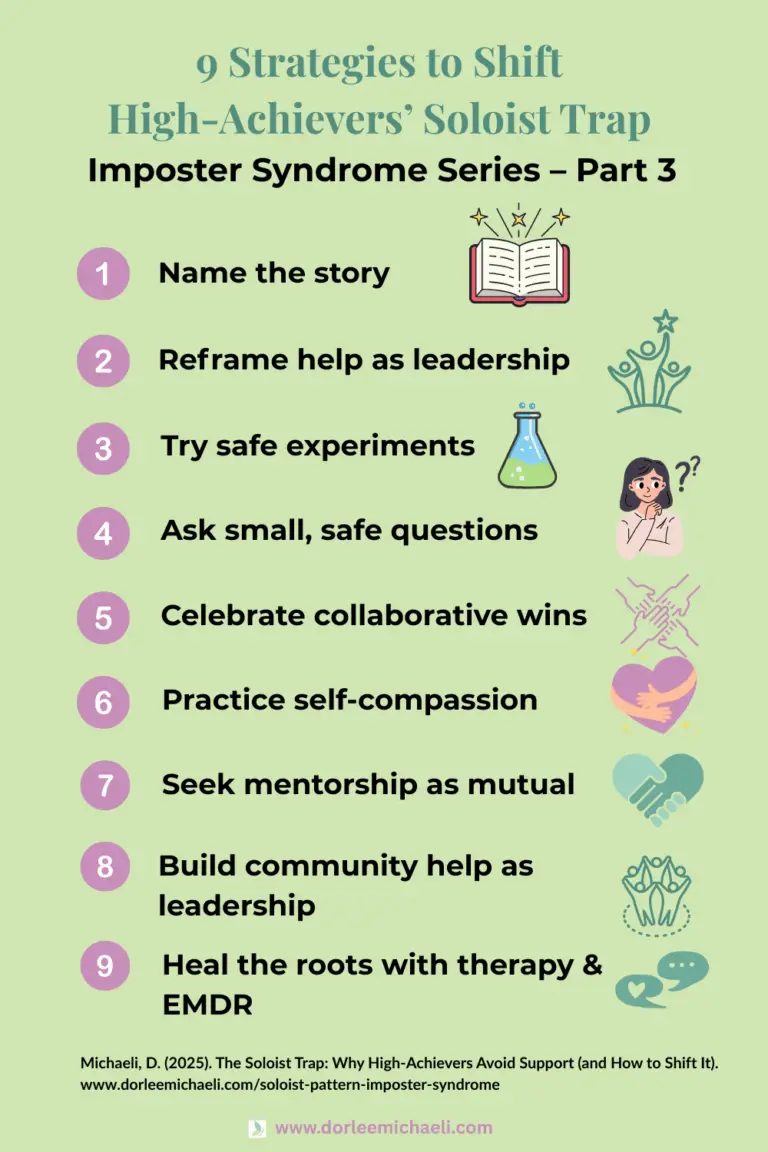
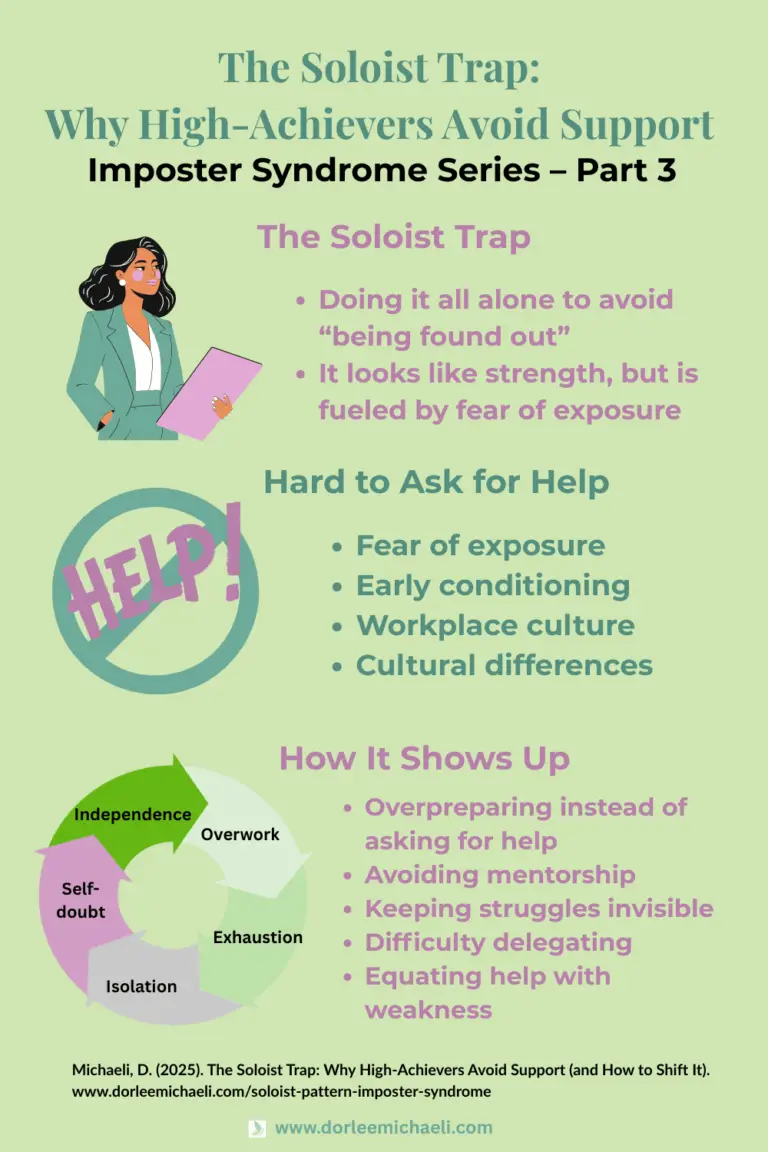



Dorlee, this is another research, knowledge and experience-rich article. You put such thought into each piece!
I hadn’t heard of the Soloist Trap before, but it is certainly relatable and a perfect title. What particularly struck me were the ideas you provided for the soloist to gradually ‘dip their toes in the water’ of being more collaborative and less independent and solely self-sufficient.
The ideas of practicing Safe Experiments and asking Small, Safe Questions really resonated because they weren’t overwhelming steps, but once completed, these small steps could create such emotional momentum.
I also REALLY liked the idea of seeking mentorship as mutual; now that I ‘think’ about it, having mutual mentorship relationships has worked extremely well for me over the past 25ish years (including my relationship with other female business owners, such as yourself!).
Thank you so much for providing such valuable support to ‘sensitive, driven souls’ (LOVE your bio!; you’ve captured the essence of your audience perfectly!).
Thank you so much for your thoughtful comment, Jacqui!
I love how you described the small, safe steps as creating “emotional momentum.” That captures the essence of what makes those experiments so powerful.
I completely agree about mutual mentorship; those reciprocal relationships have been some of the most growth-filled and meaningful parts of my own journey, too. And your kind words about my bio truly touched me. It means a lot coming from someone who understands this work so deeply.
I’m so grateful for your ongoing friendship and encouragement.
Another powerful piece in this series. I’ve appreciated how each part digs a little deeper into the roots of imposter syndrome, and how you connected the dots between safety, self-sufficiency, and imposter feelings. It’s both insightful and deeply human. Thank you for sharing this knowledge so generously. It’s helping so many of us see our patterns with more clarity and compassion.
Thanks so much, Cheryl, for this thoughtful reflection. It means a lot to know the series is resonating on that level. My hope has always been to help people see these patterns through a lens of both understanding and self-compassion, to recognize how deeply self-protection and striving can intertwine, and how healing begins when we approach those parts of ourselves with gentleness instead of judgment. Your words capture that beautifully.
Thoroughly enjoyed reading this informative and extremely insightful article, Dorlee. The Soloist Pattern is a powerful and relatable concept that highlights the tension between independence and the fear of asking for help, especially among high-achievers (I’m putting my hand up as one of them)! By acknowledging and addressing the underlying fears and cultural influences that drive this pattern, we can work to break down the barriers that prevent us from seeking support and embracing the value of collaboration, ultimately leading to greater success, well-being, and a more authentic sense of self… Brilliantly written!
Thanks so much, Cheryl, for your insightful comment and kind feedback. I love how you captured the tension between independence and the fear of asking for help. That’s really the heart of the Soloist Pattern. Your “hand up” moment will resonate with so many high-achievers. And you put it beautifully; understanding those deeper fears is what makes space for genuine connection and authenticity. With much warmth and gratitude.